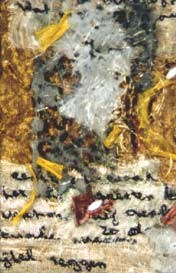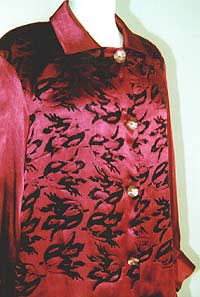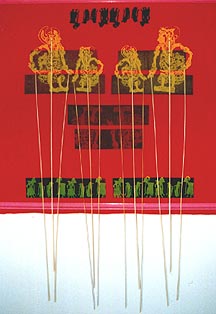BAFA © 2010. All material here is copyrighted. See conditions above. |
Nathalie Muller textiles, The Netherlands
|
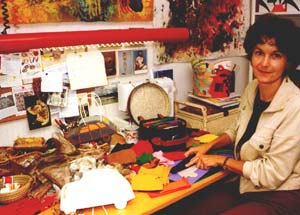 Natalie Muller in her studio
Natalie Muller in her studioThe white car-form was a pattern for a felt purse for an "Ugly Duckling Car" exhibition.
|
I completed my studies in textile design in Amsterdam in 1990. Since then, I have regularly exhibited my work in galleries for visual art and for design. I also work part time as a secretary to pay for my living costs. My art covers its own costs.
I design my own textile by painting or printing on flat cloth. Sometimes I completely re-work the material by cutting it and stitching it back together and then work with this new material. Out of these designs, I make autonomous artworks and functional designs. If I charged for the hours involved in making, say, a scarf, most people wouldn't consider buying it. I want my work to be accessible, so the price I pay for working with material that I have designed, is that I make no income from it.
|
|
This is a conscious decision. It gives me the freedom to experiment and devote myself to my work without the anxiety of having to sell it.
Generally I have an idea or theme in my head and then experiment with textile to crystalize this. In 1995 I made a series of images intended to work both as design elements for wall hangings and as functional hangings such as curtains. The images incorporated photos taken while I was in Namibia. The "Namibia" series consists of combinations of images, such as the head of a springbok (gazelle) and zebras. I was playing with form against form and so these works are exhibited as such - as large areas hung flat from the wall.
|
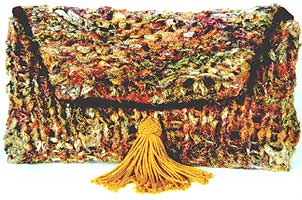 Enveloptas
Enveloptas, (Envelope-bag) various materials.
|
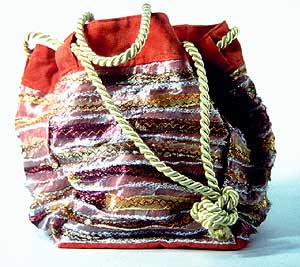 Tas
Tas, (Bag) various materials.
| As a child, I moved a lot with my family and so letters became an important part of my childhood and identity. "Brief" (Letter), 1995, consists of 50 meters of strips of velvet that are arranged on the floor as if they were threads. The particular letter used in this piece was written when I was 16. I silkscreened the letter out on one long piece of velvet and then ripped this into strips. I then attached these to each other randomly so that it is not possible to decipher a sentence from the strips. Only single words are legible.
I also made versions of this work, using the same letter but silkscreened on paper and silk. I took these threads and knitted them into self-standing handbags used for special occasions. The knitting technique involves twisting the threads so that the letters are completely hidden.
|
The form becomes very tactile. After this, I worked on a series of bags from re-worked material I created myself. In this case, I sewed strips of coloured silk together and made the bag from this.
In 1998, I was invited to participate in an exhibition on the theme of the Ugly Duckling car (2CV) and for this I made a series of Ugly Duckling car handbags. I glued colourful embroidered felt pieces over a cardboard structure. The roof opens out like a lid.
Another work, which I created in 2000, was "Déjà Vu". It is a collage of numerous pieces of embroidered silks, polyesters and small objects. I worked with these materials in various ways; for example, by heating the polyester strands in order to deform them.
I play around with textiles in much the same way that a sculptor experiments with different materials to see what they will do. Sometimes I incorporate these forms into particular works.
For the "Naar Miriam Schapiro" (After Miriam Schapiro) series, I painted colourful loose abstract forms onto silk. I was inspired by the
|
|
|
| work of the American artist, Miriam Schapiro. I used the material to make two corsets. Often I make a work and later turn it into another work. In this case, the first corset is an autonomous artwork and the other is a corset that can be worn.
The first corset, "Passie" (Passion) was made in 1999. Its shape follows the contours of my body rather than moulding my torso to a particular form. Being inflexible and made as one continuous form, it is impossible to wear. The inside of the form is made out of pieces of red velvet that fit the outer form precisely. On the velvet, I embroidered the text of a personal letter using a tracing technique that reproduced the personal characteristics of the handwriting exactly. The pieces of velvet were then cut and sewn to fit the exact contours of the corset. This makes the text illegible, although with effort it is possible to guess the meaning of the letter. On the outside, I attached a small mirror above the heart, so that while looking into the corset, the viewer can catch glimpses of her or himself.
|
|
| At the moment I am experimenting with patterns of tulip forms on silk-viscose, a material consisting of a layer of silk with a layer of viscose over this. I silkscreen on the material (using the 'devoree' or the 'ausbrener' technique) a paste containing chemicals that burn away the viscose layer when is is heated.
After this, I dye the object in different types of paint, to give its components their own colour and character. In this way the tulips are expressed not only in the different colours but also in various thicknesses of the material itself. I make shirts, tops and scarves from these designs.
Left: Silkscreen designs with woven-in wooden sticks onto a cloth and a painted frame. It is about 100 x 150 x 20 cm.
|

Arts Dialogue, Dintel 20, NL 7333 MC, Apeldoorn, The Netherlands
email: bafa@bahai-library.com
|
|



